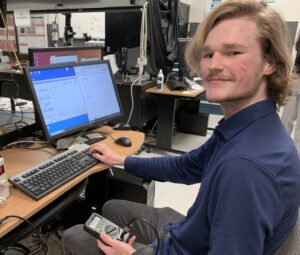
Abraham Marsh was born and raised in Honolulu, Hawaii and is currently attending Georgia Tech. He graduated from Kaiser High School and is now pursuing a BS in Electrical Engineering, with the intent of completing a MS in Electrical Engineering. Abraham loves learning new skills and enjoys hands-on technical challenges. His career interests lie in avionics and control systems. In his free time, he plays piano and guitar, ice skates, and works on personal projects.
Home Island: Ohau, Hawaii
High School:
Institution when accepted: Georgia Institute of Technology
Characterizing a New Generation of Actuators for Use in Large Deformable Mirrors
Project Site: University of California Observatories, Santa Cruz, CA
Mentor: Phil Hinz
Project Abstract:
The University of California Santa Cruz Laboratory for Adaptive Optics (LAO) works to develop large deformable mirrors that allow telescopes to compensate for wavefront distortion due to atmospheric turbulence. This technology requires hundreds of fast, high-precision actuators to deform the mirror; however, current deformable mirror technologies are small and require active cooling. The LAO has received hybrid variable reluctance actuators that require 75 times less power in a compact form, which could be implemented in higher densities without the need for active cooling. Before implementing these new actuators, the LAO must prove that the new design is capable of the speeds and accuracies required for adaptive-optics instruments. This project was to characterize these actuators by measuring their linearity, hysteresis, and response speed, as well as experiment with how to implement the actuators into a closed-loop system. Measurements of each actuator were gathered using a capacitive sensor. The actuator was driven manually with a power-supply current. Distance and voltage data were gathered and analyzed in Python to measure hysteresis and linearity. To create a feedback loop between the actuator and the capacitive sensor, I designed a Python program to read and interpret the capacitive sensor data. A software program that can drive the actuators was combined with the capacitive sensor readings to create a closed-loop system where the actuator adjusts its distance based on feedback from the capacitive sensor. A digital-to-analog circuit is needed to allow for software to control the actuator.